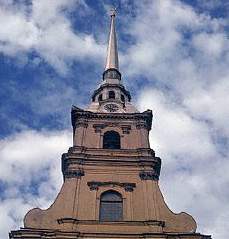 Russian Navy Day | ||||||||||
 Peter and Paul's Cathedral | ||||||||||
|
The City Layout
The Petrograd Side
Upstream of the bifurcation of the Neva is the Petrograd Side, where the great Peter-Paul Fortress faces the Strelka across the Malaya Neva. Founded in 1703, this fortification, the city's first structure, initially had earthen walls, but these were soon replaced by stone walls 40 feet high and 12 feet thick, with 300 cannons mounted on the bastions. Above the squat horizontal lines of the fortress's massive walls soars the slender, arrow-like spire of the Cathedral of St. Peter and St. Paul, a golden landmark for the city. The cathedral was built in 1712-33 by Trezzini, and the tsars and tsarinas of Russia from the time of Peter the Great (except for Peter II and Nicholas II) are buried in it. Trezzini also designed St. Peter's (Petrovsky) Gate (1718) as the eastern entrance to the fortress. The Neva Gate, designed by Nikolay A. Lvov, dates from 1787. From the early 19th century the fortress was used as a prison, chiefly for political prisoners. Today it is a museum. At noon each day a cannon is fired from its battlements.
Just to the east of the Peter-Paul Fortress, where the Bolshaya Nevka River begins, the cruiser Aurora is permanently moored as a museum and training vessel for the Naval College (see photograph). It was the Aurora that in 1917 fired the blank shot that served as the signal to storm the Winter Palace.
The Vyborg Side
The northeastern part of the central city had by the late 19th century developed into an industrial suburb. One of its most famous features is the Finland Railway Station, which faces the Admiralty Side across the Neva. Lenin returned to Russia in April 1917 via this station, and there he made his initial pronouncement of a new course that would bring the Bolsheviks to power. A major street of the Vyborg Side is the Sampson Prospekt, along which stand such buildings as the Cathedral of St. Sampson, that gave the prospect its name.
Next | Main Page | Our Service | Mail Us